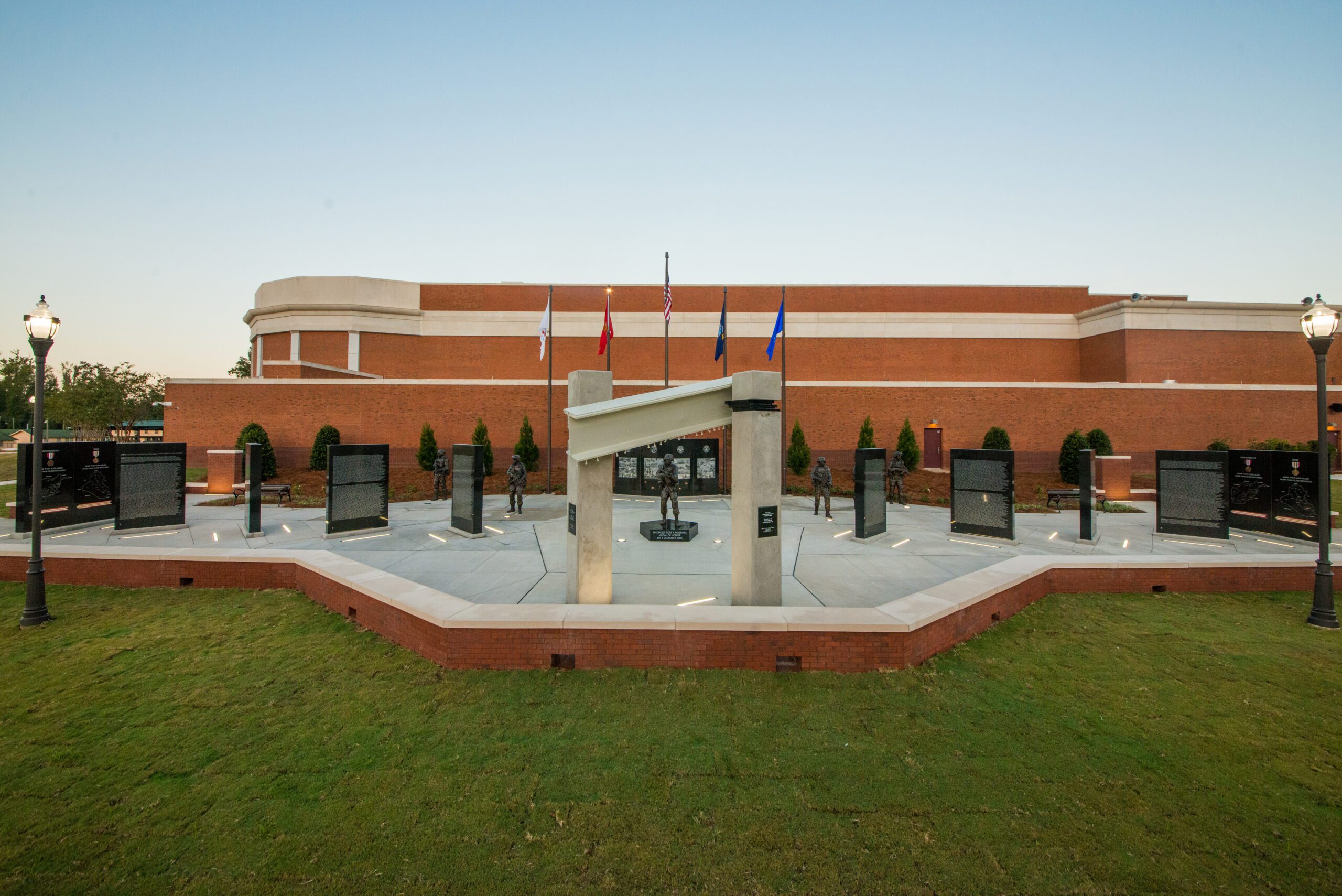National Infantry Museum
National Infantry Museum
Thayer-Bray Construction
Aaron & Clements, Inc
Under overcast skies in a solemn but celebratory ceremony, the National Infantry Museum in Columbus, Ga., dedicated a memorial for the Global War on Terrorism. At least 2,500 people attended the ceremony, including high-ranking military personnel, the NYC Fire Chief, soldiers from Fort Benning, civilians, and 200 members of the Gold Star Families who have lost sons and daughters since the beginning of the Global War on Terrorism in 2001.
The ceremony was a moving and honor-filled tribute to our nation’s fallen sons and daughters. But just as the Global War on Terrorism isn’t over, its namesake memorial remains ongoing as well. With a thoughtful design to allow for future additions, the Global War on Terrorism memorial will continue as a living memorial, paying tribute to the fallen – both past and future – in the ongoing struggle against terrorism.

Design Elements
The memorial consists of eight 5-foot by 8-foot and eight 4-foot by 8-foot panels of Raven Noir granite in a polished finish. The stone panels that bear the names of the fallen are positioned separately and at angles to call to mind that the Global War on Terrorism isn’t a singular, linear event. The panels required complex carving including images, narratives chronicling the war and a large volume of names. But the experienced fabrication personnel successfully met the requirements.
Coldspring, the fabricator of the panels, etched the names of 6,800 service members who have died in the Global War on Terrorism since September 11, 2001. Compiling the names into one document was an arduous task, facilitated by the project’s construction management firm, Aaron & Clements Inc., of Columbus, Ga.
“Since we didn’t have a file of all the names, we hand-typed the 6,800 names that Coldspring would engrave into the panels,” explains Phyllis Aaron of Aaron & Clements. “It was a meticulous process because accuracy was imperative.”
The black granite with a polished finish provided the background needed to accurately display the engraved names, an important design element found in other national tributes. Like the Vietnam Veterans Memorial in Washington, D.C., visitors may produce a rubbing of their loved one’s name from the panels as a special remembrance.
Some portions of the granite panels remain without names, as a somber reminder that the war is not over. New names will be etched in the spaces each year, and a rededication to honor the additions will be held annually on the first Saturday after Labor Day.


“When the NYC firefighters gave us the beam, we knew it had to be a centerpiece, to memorialize those who responded to the attacks on September 11,” explains Greg Camp, National Infantry Museum President and Chief Operating Officer. “In a high to low orientation, the beam intersects the concrete columns in proportion to where each Twin Tower was hit.”
The memorial also incorporates nine life-size bronze statues by Alan Cottrill Sculpture Studio, representing a squad of infantry soldiers. A centerpiece statue stands on a pentagon-shaped granite pedestal, in the likeness of Specialist Ross McGinnis. McGinnis was the first Army infantry soldier to be awarded the Medal of Honor posthumously in the Global War on Terrorism.
Worth a Thousand Words
Designed to honor all branches of the armed forces, the memorial also includes images etched into four of the Raven Noir granite panels of each service’s role in the Global War on Terrorism. The pictures etched into the granite are intended to pay tribute to all veterans of the war, not just the deceased.
Selecting the right images proved one of the biggest challenges of the project.
“We didn’t want to presuppose what the best representation of contributions by the Marines, Air Force, Navy or Army would be,” says Camp. “It was a collaborative effort, where a senior officer from each branch of service weighed in on the selection process.”
Coldspring provided guidance on which images would reproduce well with their engraving technology. The high-tech sandblasting process allows the transfer of images into granite with lifelike precision. Through the sandblasting process, various shades of gray were etched into the stone.
For sandblast projects, stone selection is a critical decision. Typically, a dark-colored stone is used to create an effective and necessary contrast against the images inscribed into the stone. Likewise, the image itself must have an appropriate level of contrast.
“One challenge was understanding the color composition,” explains Aaron. “We needed to transfer color images to a black and white representation, so we had to find images that would work for the granite production process. Coldspring did a fair amount of hand-holding and advising during this process.”
To meet the strict dedication deadline, the team at Coldspring worked closely with Aaron & Clements to ensure on-time installation.
Living Memorial
With its first rededication held September 8, 2018, the Global War on Terrorism memorial holds true to its mission of being a living memorial – one that will continue to honor sacrifices made in the ongoing war against terrorism. For more information, visit www.nationalinfantrymuseum.org.
To discover more about the kinds of creations Coldspring has made with our materials, reach out to us today.